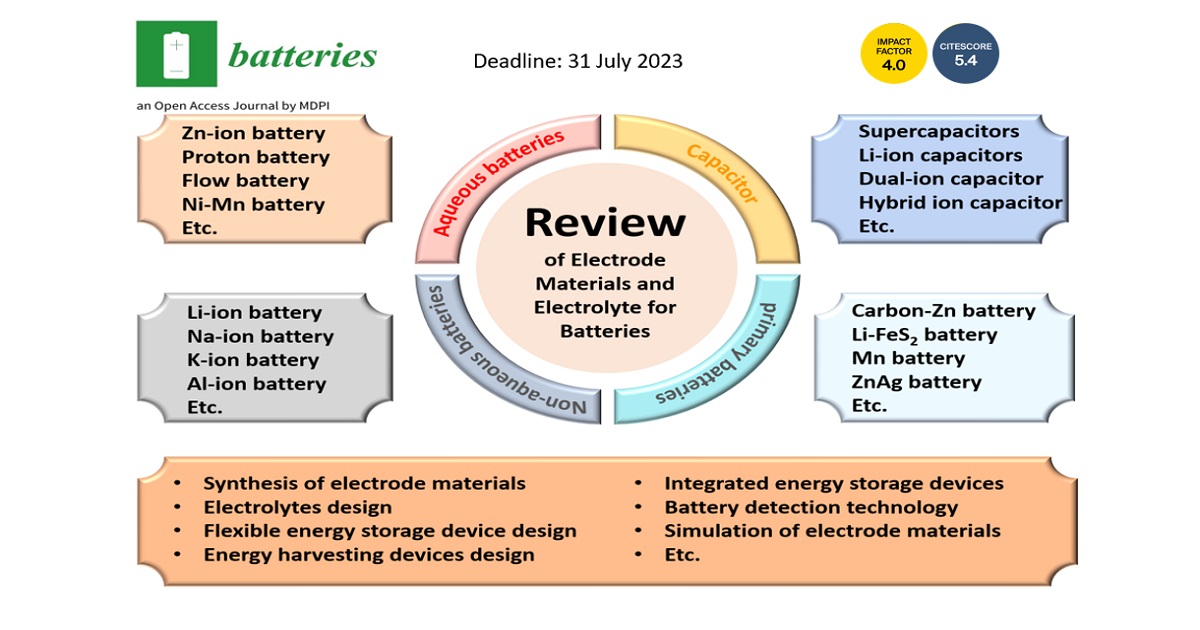Review of Electrode Materials and Electrolyte for Batteries
A special issue of Batteries (ISSN 2313-0105). This special issue belongs to the section "Battery Materials and Interfaces: Anode, Cathode, Separators and Electrolytes or Others".
Deadline for manuscript submissions: closed (31 July 2023) | Viewed by 17148

Special Issue Editor
Interests: electrode materials; electrolyte; lithium/sodium/potassium ion batteries; photocatalysis
Special Issues, Collections and Topics in MDPI journals
Special Issue Information
Dear Colleagues,
Due to the intermittent nature of clean energy, a mismatch between energy supply and demand arises, which seriously restricts the large-scale application of renewable energy. To improve the utilization efficiency of clean energy, research on high-performance energy storage systems has become an urgent need. High-performance electrode materials are key to improving the electrochemical performance of batteries. Understanding the relationships between electrochemical performance, structure, surface, and the defects of electrode materials is of great significance to the design of electrode materials. In addition, electrolytes are also closely related to the electrochemical performance of batteries. Consequently, the design of high-performance electrolytes is also of interest.
This Special Issue aims to publish high-quality review papers in Batteries which summarize the recent progress related to electrode materials and electrolytes for batteries. The scope of this Special Issue includes, but is not limited to: the synthesis of electrode materials, electrolyte regulation mechanisms, and electrochemical enhancement mechanisms. We also welcome reviews involving the simulation, optimization, and design of integrated devices and flexible energy devices. At the same time, we sincerely hope that this Special Issue can provide some new ideas for the further development of the batteries field.
Dr. Jinliang Li
Guest Editor
Manuscript Submission Information
Manuscripts should be submitted online at www.mdpi.com by registering and logging in to this website. Once you are registered, click here to go to the submission form. Manuscripts can be submitted until the deadline. All submissions that pass pre-check are peer-reviewed. Accepted papers will be published continuously in the journal (as soon as accepted) and will be listed together on the special issue website. Research articles, review articles as well as short communications are invited. For planned papers, a title and short abstract (about 100 words) can be sent to the Editorial Office for announcement on this website.
Submitted manuscripts should not have been published previously, nor be under consideration for publication elsewhere (except conference proceedings papers). All manuscripts are thoroughly refereed through a single-blind peer-review process. A guide for authors and other relevant information for submission of manuscripts is available on the Instructions for Authors page. Batteries is an international peer-reviewed open access monthly journal published by MDPI.
Please visit the Instructions for Authors page before submitting a manuscript. The Article Processing Charge (APC) for publication in this open access journal is 2700 CHF (Swiss Francs). Submitted papers should be well formatted and use good English. Authors may use MDPI's English editing service prior to publication or during author revisions.
Keywords
- synthesis of electrode materials
- electrolytes
- lithium-ion battery
- sodium-ion battery
- zinc-ion battery
- proton battery
- aqueous secondary battery
- flow battery
- metal battery
- zinc–manganese battery
- supercapacitors
- new types of battery
- flexible energy storage device
- integrated energy storage devices
- energy harvesting devices
- simulation of electrode materials for energy storage devices





